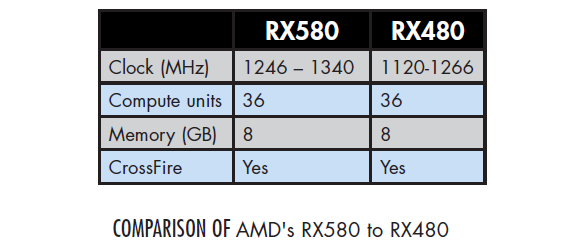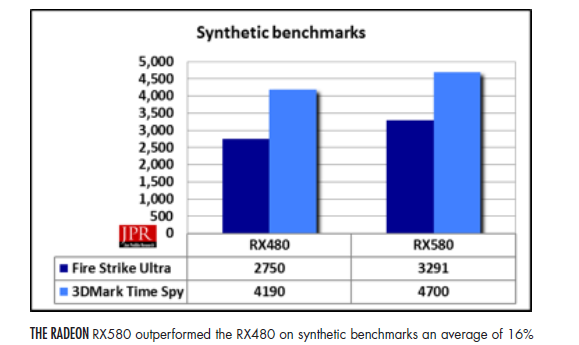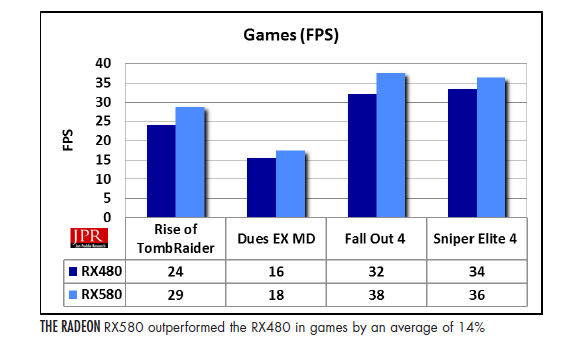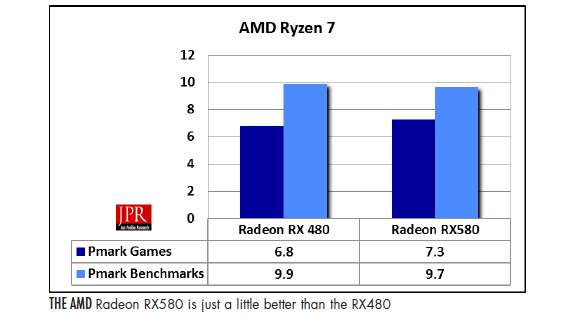Better than the RX480 on all tests
AMD just announced the mid-life kicker, and probably end of the line of the Polaris GPUs, the Radeon RX580.
We ran a suite of tests on the new AIB, and found it to be on average 15% faster than the Radeon RX480.
Because we got such good results with the AMD Ryzen PC when testing the new Nvidia AIB, we ran the series of tests of the Radeon RX AIBs on an AMD-powered CyberpowerPC (3.6 GHz Ryzen 1800x), and used four games (DeusEx MD, FO4, Sniper Elite 4, and Tomb Raider) and two benchmarks (FireStrike Ultra, and TimeSpy). The results were very satisfying and we found that the RX580 was a solid performer, beating the RX480 in all tests.
Because the test are so dramatically different, and the scores so different, we ran and reported on the synthetic benchmark tests separately, and show that in the following diagram.
As the chart indicates, the RX580 was an average of 16% faster than the RX480 which is a significant difference for a mid-life upgrade.
We also ran the new AIB against the last generation AIB using actual games and got the results shown in the following chart.
The specifications are basically the same for the two units with the exception of the GPU clock speed. The RX580, like its predecessor can run Eyefinity with up to four, disparate monitors in mixed orientation, a unique feature AMD enjoys. The AIBs also support free-sync for those monitors that offer it.
The RX 580 has two-8-pin power sockets, and the RX480 only has one. The RX480 with one 8pin is about 150W power draw, ±10W depending on load. The RX580 with two 8pin is about 180W power draw ± 20W depending on load.
The GPU clock speed of the RX580 is from 11.3% on the base frequency to 5.8% on the max frequency higher than the RX480. That means the AIB obtained about a 3x performance improvement per clock tick increase. That leads one to speculate on how far that relationship would last—if we doubled the clock would it be six-times faster?
Regardless of such speculations, when other factors are considered such as power and price, and we employ the Pmark, the story gets interesting.
We compared the Radeon RX480’s Pmark to the Radeon RX580 and were surprised to find the RX580, which sells for the same price as the RX480, has a better Pmark, mostly due to its improved performance on games, but didn’t fare as well on the synthetic benchmarks, as shown in the following chart.
We ran the RX580 at its factory settings and no doubt would have gotten better score if we tweaked the clock. Also, if you run at factory speed, the wattage power consumption should be lower, and that would give the RX580 an overall higher Pmark.
What do we think?
When we ran the RX480s in Crossfire more, we saw an average gain (across two platforms and for six tests) of 88%, which put the two RX480 AIBs, close (4%) to the GTX1080 in the Fire Strike Ultra test.
The RX580 is about 52% of a GTX1080Ti (from the above chart). If two RX580s could average 88% performance, then two RX580s would get within 15% of a 1080Ti. Two Radeon RX580 AIBs would cost $460, which is 66% the cost of one GTX1080Ti, so if you could get 88% the performance for 66% the cost, that would be a good deal, except that it would use 31% more power.
After AMD meets the demand for the RX580 and supply loosens up a bit, we’ll get another RX580 and test this theory. We’ll also know the price then and evaluate the price-performance benefits of using two RX580s vs. on GTX1080Ti.
However, this may all be moot if Vega is as awesome as AMD is suggesting. AMD missed this wave of high-end AIBs, bringing out the RX480 in the midrange. Nvidia demonstrated that there is a lot of demand for high-end AIBs, and almost regardless of price. So in addition to losing market share in the high-end, AMD left some very high-margin business to Nvidia. Vega will try to take back some of that business, and the RX580 and family will try to fill in the rest of the demand in the meantime.





